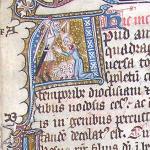MARTYROLOGY
Vellum, 7.375 x 5.75, ff. 54 + 10, 31 lines to a page. 14th cent., good
English hand.
Stamped leather (16th cent.) over boards.
Donor, T. C. S. Priced 13s 4d. and also 20s.
At end:
Constat Magistri Xpof. Caldecott (xv).
Ex Dono Thome Gyles. a. d. 1558 xii May.
The covers are lined with two pieces of a very fine 15th cent. Missal written in England. In the piece at the end is an excellent decorative initial.
The book belonged to (but was not written for) the Collegiate Church of Fotheringhay, see below.
Collation: 2 flyleaves, a6, 16 28 – 78, 2 flyleaves.
On flyleaves, a circle with numbers 1 to 30 written round it.
Contents:
English poem (xv): prognostics from the days of the week on
which the year begins.
die dominica.
Tell we nowe of {th}t {y}ere
that begynnyth wt jenyver.
Ends: but kepe {th}i wete ffast
{th}u schall haue nede at {th}e last.
Nota. Hoc Ebrayce scriptum de diebus Natiuitatis domini inuenit
Esdras propheta in templo Jerusalem. Si primus dies natiu.
domini erit in dominica hiemps bona erit et.
Galyen techyth wyche metes and drynkes ar gode to use in tyme of
blode letyng. ivb-via blank.
Miscellaneous notes on Kalendar and Signs, e.g. f. vib
Martini Blasii philippi Bartholomei.
hiis festis minuas ut longo tempore uiuas. quod hare.
Kalendar in red and black . . . . . . . 1
Martyrology . . . . . . . . . 7
Hic inc. martilogium. Nono kal. ianuarii.
Apud antiochiam syrie natalis SS. uirginum quadraginta, etc.
Good, rather rough border, and initial of executioner beheading a
kneeling woman (one of the 40 Virgins of Antioch): other heads
lie on the ground.
Ends f. 52a: deposicio domini chilberti regis. Sic omnes lectiones
martilogii per annum finiantur. Et aliorum plurimorum SS.
martirum confessorum atque uirginum.
In a later hand:
Office of St Gabriel . . . . . . . . 52b
ending 53a.
There are a good many additions to the Kalendar, which is generally
speaking Sarum, and some in the text of the book, e.g.:
Feb. 6. S. Dorethea.
Mar. 1, 2. David and Chad.
15. Longinus.
18. Geretrudis.
Ap. 11. Dep. S. Guthlaci C. et anachorite.
27. Sithe V.
May 17. Transl. S. Bernardi.
26, 27. Augustine, Bede.
June 3. Herasmus.
21. Decollacio S. Wenefrede.
22. SS. decem milia mm.
July 2. Visitation of the B. V. M.
16. Osmund.
Aug. 21. Bernard.
Sept. 10. Ob. Thome Yong. a. d. 1493 litera dominicali f.
28. Ob. d. Martini Eylande.
Oct. 6. Transl. S. Hugonis in red.
(15. Wlfran in red original.)
17. Etheldreda added in red.
Ob. Willelmi Lacy.
19. Fredeswide in red.
Nov. 3. Wenefreda.
Dec. 8. Ob. Mri Xp’oferi Caldecot a. d. 1506 litt. dom. D.
In the text:
13 kal. Feb. Wulstan.
16 kal. Mar. Eormenhilda
4 Id. Mar. Elpheage of Winchester.
5 kal. Mai. Sitha.
3 Non. Jun. Herasmus.
5 Id. “ Transl. S. Edmundi.
17 kal. Jul. Eadburga.
15 “ “ Transl. S. Ricardi.
12 “ “ “ “ Edwardi R. M.
11 “ “ Decollacio S. Wenefrede.
10 “ “ x millia martirum.
5 “ “ Apud glestoniam transl. S. Benigni C.
5 Non. Jul. Visitacio b. M. (later).
17 kal. Aug. Osmund.
7 Id. “ Festum nominis Jhesu.
2 “ “ Clara.
5 kal. Oct. Ob. Mri Breton et Ricardi Worthyngton.
4 Non. Oct. Ob Henrici Bracy.
Prid. Non. Transl. S. Hugonis.
8 Id. “ Apud monasterium glestingensium transl. SS. Aidani antistitis
et Ceolfrithi Abb.
7 Id. “ In britannia S. Iwi Conf. et Oswaldi archiep. et conf.
6 Id. “ Ob. Ric. Sapcot militis.
4 Id. “ In britannia. Dep. S. Wylfrithi Ep. et C.
16 kal. Nov. Transl. S. Etheldride de cuius laude versificator ait (verses on
her in lower margin)1.
14 kal. Nov. Wyneffrida V.
6 “ “ Ob. Edwardi ducis Eboraci fundatoris istius collegii.
2 Non. “ Brinstan.
4 Id. “ Justus.
18 kal. Dec. Transl. S. Erkenwaldi.
10 kal. Jan. Parisius dedicacio basilice in honore S. Crucis et natale
S. Vincen(tii).
This Edward Duke of York founded the College of Fotheringhay in
the sense that his father Edmund of Langley made the Church collegiate
and built the choir in his memory. He fell at Agincourt. Edward IV
added a cloister and sepulchral chapel.
1 viz. Etheldreda bonis et famos(si)ssima donis
Virtutum magnis. pia quater quatuor annis
Intergra post obitum quasi spernens soluere ritum
Corporis in membris sexto decimoque nouembris
ffertur kalendas translata colendas (sic)
Que rogo festa dies sit monachis requies.
Negative microfilm in St John's College Library.
The Middle English verses on fols ii-iii are published in R. H. Robbins, 'English almanacks of the fifteenth century', Philological Quarterly 18 (1939), 324-8.
Laurel Braswell-Means, 'The vulnerability of volvelles in manuscript codices', offprint from Manuscripta 35 (1991), 43-54.
